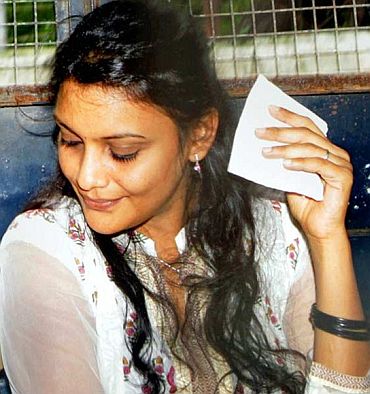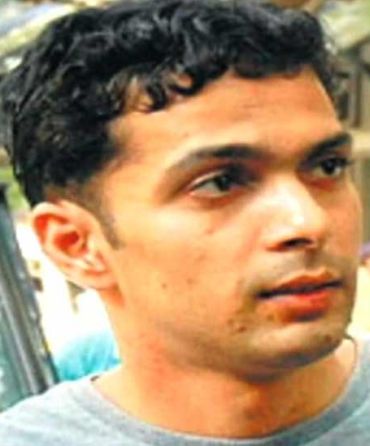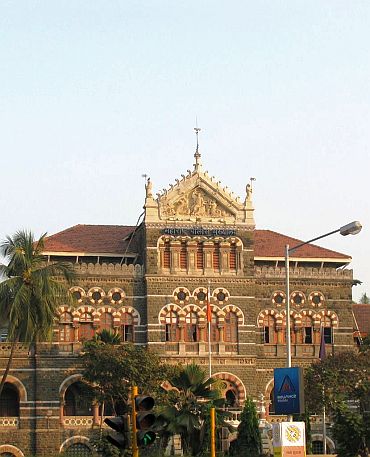Toral Varia in Mumbai
Between the Mumbai crime branch announcing the cracking of the sensational Neeraj Grover murder in May 2008 and the culpable homicide not amounting to murder verdict last week, lies a tale of shoddy case preparation. Toral Varia picks holes in the prosecution's case against Maria Susairaj and Emile Jerome
It has all the makings of a perfect film plot. Monica Maria Susairaj, a small-time struggling actress from the south of India, comes to Mumbai to try her luck in the big bad world of Bollywood. Hoping to get a break in the film industry, Maria gets friendly with a television executive, Neeraj Grover.
Maria's fiance Emile Jerome, a lieutenant with the Indian Navy, suspects Maria of cheating on him. In a fit of rage, Emile flies to Mumbai from his base in Cochin, storms into her rented apartment in suburban Mumbai, spots his girlfriend with Neeraj, and gets into a tiff with him. One thing leads to another and Emile Jerome ends up stabbing Neeraj Grover to death. Maria Susairaj helps him in disposing of the body by chopping it into pieces and burning the remains in the jungles of an adjoining district.
Eventually, however, the law catches up with them. The police arrest both Emile and Maria, the macabre disclosures stun even the most hardened Mumbaikar, the case goes to trial in which both the accused are convicted and sentenced. Lightly, which sets off a storm of outrage.
The verdict has also given rise to several questions that are buzzing in the legal corridors. Were the conviction and the sentencing proportionate to the crime committed by the two? The Mumbai crime branch claimed they had enough evidence -- material and circumstantial -- to link up the crime with the accused, didn't they? Did the prosecution build a watertight case? What went wrong? Where did the prosecution fail?
Without getting into the minutiae, let's quickly take you through the evidence that the crime branch claimed was clinching and the charges under which Emile Jerome and Monica were booked.
The naval officer and his girl friend both were booked for murder and conspiracy under Section 302 read with 120 (b) of the Indian Penal Code, destruction of evidence and giving false information under section 201 of the IPC, and under section 34 of the IPC for having a common intention to murder.
What Neeraj's friend told the court about Maria
The prosecution relied on two kind of evidence -- material and circumstantial. All through the trial, the prosecution relied heavily on the circumstantial evidence, trying to link the dots of this gory crime to secure a logical conclusion at the end of the trial.
Again, skipping the nitty-gritty, let's go through the basic evidence that the prosecution relied on. In all there were 48 prosecution witnesses and 19 defence witnesses.
According to the prosecution, cell tower location for the phones of both Neeraj Grover and Maria Susairaj were same for some time before, during and after the murder. Hence, according to the prosecution, Monica and Neeraj were together at the time of murder.
To prove that both Neeraj and Maria were beyond being just friends, the prosecution relied on several eye-witnesses, especially Nishat Lal, a close friend of Neeraj Grover.
Lal deposed before court stating that he met Neeraj and Monica at a party together, where Neeraj had privately informed him that he (Neeraj) was in a physical relationship with Monica. Further, he added that he had himself seen the two getting intimate in the party.
Nishat Lal also claimed to have made three calls to Neeraj on his mobile phone on the intervening night of May 6 and 7. On one occasion he even spoke to Maria.
The prosecution produced a leave and licence agreement (property lease) in the name of Maria Monica Susairaj. Further, to prove that Maria was in possession of flat number 201 in Dheeraj Solitaire apartment, the prosecution relied on two estate agents and Monica's close friend and neighbour Mayuri Prajapati.
In her deposition, Mayuri informed the court that she was introduced to Neeraj by Maria on the night previous to the murder (May 6, 2008) from a distance of approximately 15 feet.
Call data records let case down
Then there were the depositions of two watchmen who told the court that they had seen both Emile and Maria loading the car with two travel handbags and leaving the society; Maria's friend Kiran who confirmed that the former had borrowed her car; the petrol pump attendant who deposed saying that he made an exception by selling petrol in two cans of five litres each because Jerome flashed his defence identity card; the painter who identified Emile and Maria as the couple with whom he was discussing painting the flat after the murder; Neeraj's cousin Nishant who told the court that Maria handed him Neeraj's mobile saying that he had forgotten it at her house.
In terms of forensic evidence, the police recovered one piece of vertebrae, one femur bone, skull, Neeraj's chain, pendent and ring. The police claimed that they also found traces of petrol.
One of the main pieces of evidence the prosecution heavily relied upon was the call data records of Neeraj to show that he was with Maria Susairaj through the night of May 6-7, 2008. In any case, CDR is accepted as evidence only and only if it is in chronological order. In this particular case, in the CDR that was submitted before the court, the call timings were jumbled up and thus not in chronological order.
For instance, if one call is shown at 11.25 pm, the next call is shown at a time prior to it. To be accepted as evidence, it is imperative that the call records are in chronological order. If they are not, then it means only two things -- either there was a problem in the server, or the CDR has been tampered with. In both the cases, legally the CDR has to be disbelieved.
In this case, the prosecution insisted on relying on the faulty CDR to further the trial.
Prosecution could not prove fact of murder beyond reasonable doubt
Image: Emile JeromeAccording to the CDR, on May 7, 2008, there were a total of eight incoming calls between 11.30 am and 11.45 pm which were responded to and the duration of these calls ranged from 17 seconds to 173 seconds. The prosecution produced neither any evidence nor any witness to show that someone was operating Neeraj's mobile phone. Who was responding to these calls? Was it Maria? Was it Emile? Or was there anyone else on the scene? Or was it Neeraj himself?
It was this faux paus that cost the prosecution dearly, and seemed to have helped the defence build a strong case in its favour and help the accused to come clean from the grave charges of conspiracy and murder, under section 120 (b) and section 302 of the IPC.
In her confession, Maria accused Jerome of raping her twice. Once in front of the corpse, lying in a pool of blood with Jerome holding a chopper in his hand, and the second time inside the bathroom. But curiously, the prosecution not only failed to produce any evidence that could refute her claim, it did not even so much as conduct a basic medical examination on her to verify whether she was indeed raped or was she just trying to shift the blame on to Jerome.
The prosecution could not prove two most important aspects of the case -- intent to commit the crime, in this case a murder, and the time of the murder. There was no expert opinion placed before the court by the prosecution proving beyond doubt the time and the fact of murder. Something that the prosecution could have easily produced during the course of its coordination with forensic experts for several tests.
How the police let down the case
In a criminal case of this nature, the chain of events should be established and linked beyond doubt. But the deposition of several witnesses has been partially doubted. For instance, the deposition of the two watchmen has been questioned. Critics ask how they could remember only Emile and Maria, when they don't seem to have answers to anything else related to the housing society or the people living in it?
Despite three depositions stating that an entry and exit register is maintained in the building, the prosecution failed to produce the building register, a significant piece of evidence that could have established Neeraj's time of arrival in the building. There were several discrepancies in the statements of the investigating officers. Important pieces of evidence like case diary, police station diary, seal register and travel register were not produced before the court to corroborate the officers' statements. These could have helped the prosecution to establish the sequence of circumstantial evidence.
After Maria's arrest, she led the investigators to the spot in the Manor jungles where the police found the remains of Neeraj Grover, a ring and a chain. However, the prosecution's claim of also finding petrol and flesh on the remains came under scrutiny given that the remains were found a good two weeks after the murder. But more importantly, the remains were found in an open, less frequented area of the jungle and could have been open to wild animals and weather changes.
While the body was found on May 22, 2008, at Maria's behest, the weapon with which Neeraj was chopped into pieces was found just 20 feet away from Neeraj's remains two days later, on Emile's information. It's quite unbelievable that the investigators did not look around at all on the first occasion when they visited the site to recover the remains. The investigating officer deposed before the court stating that there were several smaller areas with burnt marks around the body. Then why did the officers not go and investigate the location the first time itself?
After the initial missing complaint on Neeraj Grover was registered, a police team regularly visited Maria Susairaj's apartment. But the officers managed to locate the kitchen knife used to stab Neeraj to death, near the drainage area of the balcony in the apartment only after Emile was arrested and interrogated. What did the police investigate prior to this?
Will the prosecution fare better on appeal?
The prosecution also failed to prove the charge of conspiracy, with the court categorically observing that there was nothing to show or prove that Emile and Monica had any prior plans to murder Neeraj Grover. Hence, Emile was finally convicted under the charge of culpable homicide not amounting to murder and not the grave charge of murder.
Even though Maria had confessed to her crimes, the prosecution did not rely on her confession. But since the prosecution could not complete the chain of circumstantial evidence beyond doubt, the court relied on her confession to a great extent. Maria Susairaj changed her stance several times during the trial.
One gets a sense that the prosecution had made a lot of assumptions which were legally not tenable. Since the case was based on circumstantial evidence, every link in the chain had be proved "beyond reasonable doubt" to secure a conviction, which the prosecution only partially managed to achieve. But could they have done better?
The state is expected to file an appeal in the Bombay high court against the session court ruling once the judgment copy is handed over the prosecution and the defence. Will the prosecution have better luck second time round?







article